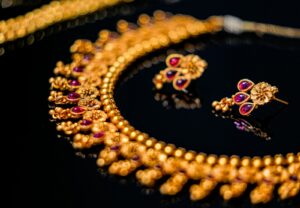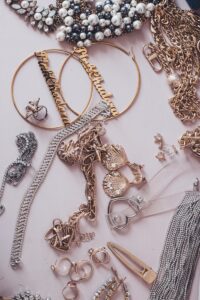Imagine tracing the glittering path of fine jewelry through the ages, where each piece not only dazzles the eye but also carries rich tales from the past. Exploring the history of fine jewelry offers a fascinating glimpse into the artistry and cultural significance that have shaped human civilization. From ancient royal crowns to the avant-garde pieces adorning today’s fashion icons, jewelry has always been more than mere decoration; it’s a profound expression of personal and collective identity.
As you delve into the history of fine jewelry, you’ll discover how styles and materials have evolved, reflecting societal changes and technological advancements. The shift towards sustainable and ethically sourced materials highlights a modern commitment to responsible luxury. Understanding this history enriches your appreciation of every piece, whether it’s a family heirloom or a new addition to your collection, making each jewel tell a story of its own.
Ancient Origins of Jewelry
Early Jewelry in Mesopotamia and Egypt
Discover the intricate world of ancient jewelry, starting with Mesopotamia and Egypt, where the craft of fine jewelry truly began. Mesopotamia, often hailed as the cradle of civilization, introduced jewelry as both adornment and a symbol of status around 3000 BC. Craftsmen in this region utilized gold, silver, and semi-precious stones like lapis lazuli, creating pieces that underscored their societal importance as well as their skills in jewelry making.
In Egypt, jewelry transcended mere decoration, serving also as protection and an indicator of social status. From as early as 5000 BC, Egyptians crafted elaborate gold and precious stone jewelry. Gold, believed to reflect the gods’ eternal shine, became a commonly used material. Iconic pieces included broad collars, amulets, and even intricate beadwork, all of which played a significant role in both life and afterlife, aligning with the Egyptians’ deep spiritual beliefs.
Classical Influences: Greece and Rome
The Greeks and Romans brought their own distinctive styles and techniques to the arena of fine jewelry. The Greeks, from around 1600 BC, favored more subtle designs that commonly featured animals and natural world motifs. Their use of gold, silver, and precious gems like diamonds was a testament to their advanced gem cutting and metal crafting techniques.
Roman jewelry, evolving from Greek precedents, embraced a more lavish touch, extensively using gold and precious stones to signify wealth and power. Pieces like rings, cameo brooches, and elaborate necklaces were not just personal ornaments but also conveyed social and political messages. Jewelry worn in public arenas often reflected societal ranks and celebrated victories, deeply intertwining the concept of personal adornment with the fabric of societal structure in ancient Rome.
Each piece from these eras not only reflects the artistry and aesthetics of the time but also offers a glimpse into the societal structures, beliefs, and even the daily lives of these ancient civilizations.
Medieval and Renaissance Jewelry
Developments in Europe
During the Middle Ages, jewelry transcended mere decoration to assume roles deeply intertwined with societal and cultural norms across Europe. This period saw significant innovation in techniques and materials. Artisans began to incorporate a wider variety of gemstones and transitioned from using primarily gold to include silver and other precious metals, enhancing not just the aesthetic value but also the significance and reach of their creations.
The Renaissance brought about a dramatic shift in the approach to jewelry making, closely linked to the broader revival of arts and culture. Jewelry designs became more intricate and ornamental, reflecting the era’s newfound interest in classical learning and artistic renewal. Jewelers and goldsmiths achieved new levels of expertise, crafting pieces that not only displayed personal wealth but also denoted personal affiliations and status within the societal hierarchy. During this time, wearable art pieces included not only traditional necklaces and rings but also shoulder clasps and other forms of jewelry that indicated rank and affiliation.
The Influence of the Byzantine Empire
Influences from the Byzantine Empire were prevalent in medieval jewelry designs throughout Europe. Recognized for its opulent use of gold and gemstones, Byzantine jewelry featured complex designs with religious and imperial iconography which exerted significant influence over European styles. Complex enameling and intricate filigree work became hallmarks of the era, techniques that were perpetuated by high ranking church officials and the imperial court as symbols of earthly power and divine favor.
Artisans from the Byzantine influenced regions mastered the art of embedding precious gemstones like sapphires, rubies, and emeralds into intricately designed gold settings, a practice that laid foundational techniques still admired in the jewelry industry today. This era’s preferences for lavish decoration and expressive religious motifs also served to communicate wealth and piety, echoing the Byzantine’s grandeur long after its decline. As you explore these historical pieces, whether in a museum setting or through contemporary reproductions, you are witnessing the legacy of one of history’s most influential jewelry-making traditions.
The Age of Opulence: Baroque to Victorian Jewelry
Baroque Period Jewels
The Baroque period, spanning from the late 16th century to the early 18th century, saw jewelry that reflected the dramatic shift in art and architecture of the time. Designs were characterized by intricate details, bold forms, and a preference for lush, ornate aesthetics. This era embraced oversized and extravagant jewels, often adorned with large, centrally-placed precious stones such as diamonds, emeralds, and sapphires, surrounded by intricate settings of gold and silver. Baroque jewelry often mirrored the opulence seen in the broader cultural canvas, showcasing the deep intertwining of art and personal wealth.
Iconic pieces from this time include the lavish shoulder clasps and grand necklaces, each piece echoing the earthly power and status of its wearer. The intricate craftsmanship of these items is displayed in museums like The Metropolitan Museum of Art, where the history of fine jewelry is encapsulated within each ornate piece.
Georgian and Victorian Era Innovations
Moving into the Georgian and early Victorian periods, advancements in jewelry making saw an increasingly diverse use of materials and techniques. The period from 1714 through the mid-19th century marked a time where jewelers began incorporating a broader array of precious metals and gemstones into their work, reflecting the vast array of materials now accessible due to expanded global trade.
During Queen Victoria’s reign, jewelry designs became emblematic of her personal taste and the broader societal sentiments of mourning and romance. Mourning jewelry, crafted from materials like jet and human hair, became prevalent, symbolizing loss and remembrance. Concurrently, romantic jewelry flourished, with floral motifs and heart-shaped lockets becoming popular, often given during courtships and special occasions.
The use of different techniques like metal casting and filigree became refined during this era, demonstrating the jeweler’s skill in creating intricate and delicate designs. These pieces not only served as personal adornments but also as markers of social standing and cultural traditions, closely linked to the significant role jewelry played in expressing identity and status during the Victorian era.
Modern Transformations in Fine Jewelry
Art Nouveau and Art Deco Movements
The transition into the 20th century marked a dramatic shift in the design and aesthetics of fine jewelry, closely linked with the Art Nouveau jewelleryand Art Deco movements. Art Nouveau, emerging in the late 1890s, introduced pieces that mirrored the natural world, incorporating floral motifs, flowing lines, and organic forms. This style was greatly influenced by the Arts and Crafts movement and celebrated for transforming everyday objects into wearable art. Renowned designers like René Lalique pushed the boundaries by integrating materials such as glass and enamel, which deviated from the traditional use of precious metals.
By the 1920s, Art Deco took center stage with its geometric shapes and lavish decoration, reflecting the prosperity of the Machine Age and modern styles. Art Deco jewellery often featured a juxtaposition of bold colors and was made with extravagant jewels and a variety of precious and other precious metals. This era saw iconic pieces that were epitomes of luxury, with influences seen at events like the Paris International Exhibition. Designers such as Cartier and Van Cleef & Arpels became synonymous with Art Deco, crafting items that were both modern in appearance and rich in opulence and design.
Mid-20th Century Trends and Beyond
As the century progressed, the jewelry industry witnessed continual evolution, adapting to both cultural shifts and technological advancements. In the mid-20th century, the inclusion of semi-precious stones and the innovation in diamond jewellery and wedding rings enriched the diverse catalog of available options. This era also heightened the popularity of male jewellery, reflecting broader social changes towards gender expression in fashion.
Entering into contemporary times, the emphasis on sustainable and ethical practices began to shape the future of jewelry making. Modern designers are exploring different techniques, from 3D printing to ethically sourced materials, to create unique and meaningful contemporary jewellery. This shift not only honors the rich history of jewellery but also adapts to the growing demands of cultural responsibility and personal expression. Each piece crafted today stands as a testament to the enduring allure of fine jewelry and its capability to encapsulate both historical reverence and forward-thinking innovation.
Cultural Impact and Technological Advancements
Jewelry in Society and Symbolism
Jewelry serves as a powerful symbol in societies, holding meanings that transcend mere decoration. From ancient times to modern days, these adornments have signified status, power, and cultural identity. In ancient Egypt, gold necklaces were worn to display wealth and divine connection, while during the Renaissance, sumptuous jewelry signified noble status and intellectual might. The Middle Ages saw the use of family crests and religious icons in jewelry, further cementing its role in societal heritage and personal identity.
In India, jewelry has always been a significant part of cultural expression. The intricate designs from the Indian subcontinent are not just beautiful; they are also deeply meaningful, used in ceremonies and everyday life to symbolize protection, health, and prosperity. This tradition continues to influence contemporary jewelry designs globally, blending ancient craftsmanship with modern aesthetics.
Advances in Materials and Techniques
The evolution of materials and techniques in jewelry making has been a cornerstone of its history. The breakthroughs in manipulating precious metals, like gold and silver, have allowed for greater creativity and innovation. In ancient times, artisans used basic materials such as fish bones and colored gemstones to create pieces, but the introduction of metal casting in the ancient art of jewellery making represented a dramatic shift in potential designs and durability.
During the Art Deco period, the jewelry industry saw another transformation with the adoption of platinum and the geometric stylization of pieces that mirrored the Machine Age’s progress. Advances in technology have also led to new forms of wearable art, incorporating unconventional materials such as titanium and recycled metals, highlighting the jewelry’s ever-evolving nature. These advancements have not only expanded access to jewelry but have also played a critical role in shaping cultural trends and the jewelry market.
Final Thoughts on The History of Fine Jewelry
As you’ve explored the rich tapestry of fine jewelry’s history, it’s clear that each era has contributed uniquely to what we cherish today. From the ornate designs of the Baroque period to the innovative use of materials in contemporary pieces, jewelry has continually evolved while maintaining its deep cultural and personal significance. The journey from ancient craftsmanship to today’s focus on sustainability and ethics reflects a dynamic industry that respects its past as it forges a responsible future. Whether you’re an enthusiast or a casual observer, the story of fine jewelry offers a fascinating glimpse into the intersection of art, history, and human expression.
Other suggested articles:
Black Tie Jewelry: How to Accessorize for a Formal Event
Wardrobe Essentials for Everyday Elegance: A Stylish Guide
Exploring Iconic Luxury Fashion Brands for Women: A Must-Read Guide



